英汉习语翻译策略
- 格式:doc
- 大小:58.00 KB
- 文档页数:9
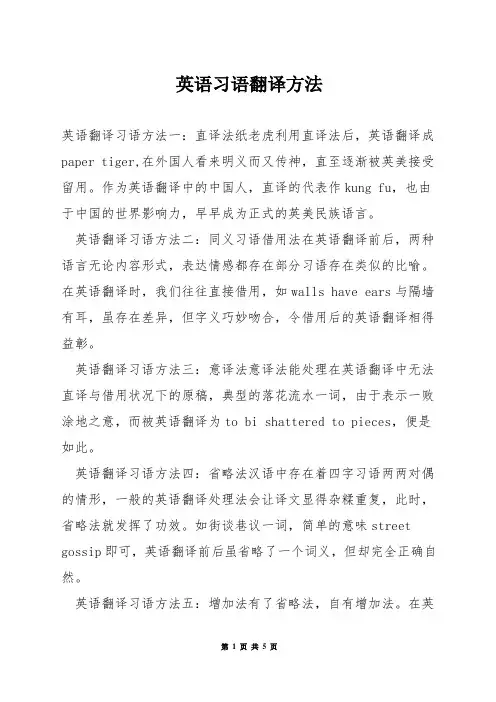
英语习语翻译方法英语翻译习语方法一:直译法纸老虎利用直译法后,英语翻译成paper tiger,在外国人看来明义而又传神,直至逐渐被英美接受留用。
作为英语翻译中的中国人,直译的代表作kung fu,也由于中国的世界影响力,早早成为正式的英美民族语言。
英语翻译习语方法二:同义习语借用法在英语翻译前后,两种语言无论内容形式,表达情感都存在部分习语存在类似的比喻。
在英语翻译时,我们往往直接借用,如walls have ears与隔墙有耳,虽存在差异,但字义巧妙吻合,令借用后的英语翻译相得益彰。
英语翻译习语方法三:意译法意译法能处理在英语翻译中无法直译与借用状况下的原稿,典型的落花流水一词,由于表示一败涂地之意,而被英语翻译为to bi shattered to pieces,便是如此。
英语翻译习语方法四:省略法汉语中存在着四字习语两两对偶的情形,一般的英语翻译处理法会让译文显得杂糅重复,此时,省略法就发挥了功效。
如街谈巷议一词,简单的意味street gossip即可,英语翻译前后虽省略了一个词义,但却完全正确自然。
英语翻译习语方法五:增加法有了省略法,自有增加法。
在英语翻译中,汉语往往简略后能让国人明义,而英语则必须要增加说明,顺合外国人对英语翻译的习惯。
如树倒猢狲散译为Once the tree falls, the monkeys on it will flee helter-skelter中的helter-skelter便是利用增加法,起到调和英语翻译的作用。
2翻译英文文章技巧拿到一篇英文,首先要略读一下,来确定文章风格。
如果是抒情式的必须要将文章翻译得优美一些。
如果是科技文章,则语言必须要偏向专业和精简风格。
要多读相关材料来熟悉所写的内容。
一篇文章都会有自身的主题,要围绕主题多读一些相关的文章,这样在翻译当中才会使用更加合适的词汇、语句。
要注意英语单词对应的语义。
英语单词在翻译成汉语会有不同的意思。
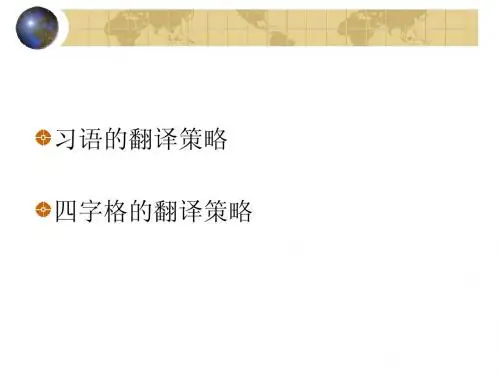
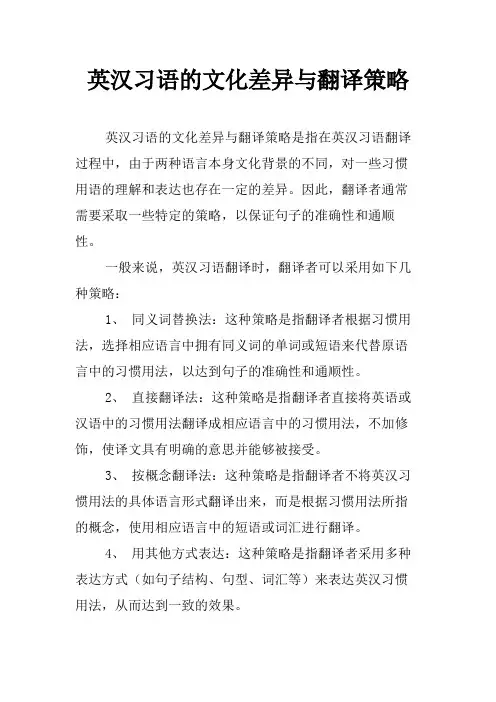
英汉习语的文化差异与翻译策略
英汉习语的文化差异与翻译策略是指在英汉习语翻译过程中,由于两种语言本身文化背景的不同,对一些习惯用语的理解和表达也存在一定的差异。
因此,翻译者通常需要采取一些特定的策略,以保证句子的准确性和通顺性。
一般来说,英汉习语翻译时,翻译者可以采用如下几种策略:
1、同义词替换法:这种策略是指翻译者根据习惯用法,选择相应语言中拥有同义词的单词或短语来代替原语言中的习惯用法,以达到句子的准确性和通顺性。
2、直接翻译法:这种策略是指翻译者直接将英语或汉语中的习惯用法翻译成相应语言中的习惯用法,不加修饰,使译文具有明确的意思并能够被接受。
3、按概念翻译法:这种策略是指翻译者不将英汉习惯用法的具体语言形式翻译出来,而是根据习惯用法所指的概念,使用相应语言中的短语或词汇进行翻译。
4、用其他方式表达:这种策略是指翻译者采用多种表达方式(如句子结构、句型、词汇等)来表达英汉习惯用法,从而达到一致的效果。
最后,英汉习语翻译需要翻译者考虑两种语言文化之间的差异,根据文章内容和读者的背景知识,采取有效的翻译策略,以保证翻译的准确性和通顺性。
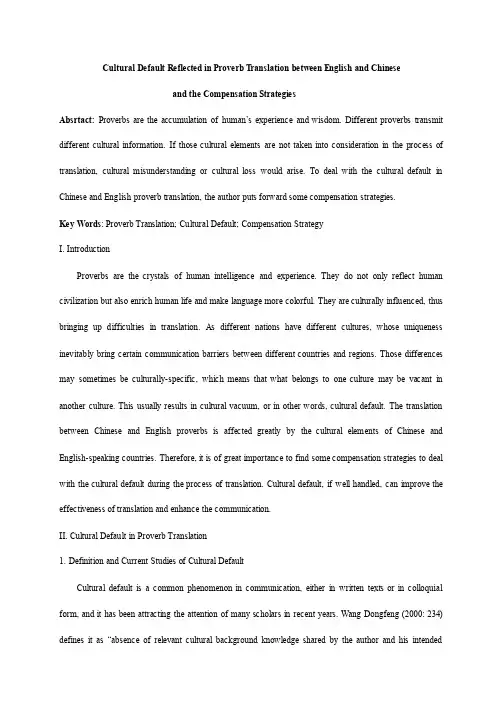
Cultural Default Reflected in Proverb T ranslation between English and Chineseand the Compensation StrategiesAbsrtact:Proverbs are the accumulation of human’s experience and wisdom. Different proverbs transmit different cultural information. If those cultural elements are not taken into consideration in the process of translation, cultural misunderstanding or cultural loss would arise. To deal with the cultural default in Chinese and English proverb translation, the author puts forward some compensation strategies.Key Words: Proverb Translation; Cultural Default; Compensation StrategyI. IntroductionProverbs are the crystals of human intelligence and experience. They do not only reflect human civilization but also enrich human life and make language more colorful. They are culturally influenced, thus bringing up difficulties in translation. As different nations have different cultures, whose uniqueness inevitably bring certain communication barriers between different countries and regions. Those differences may sometimes be culturally-specific, which means that what belongs to one culture may be vacant in another culture. This usually results in cultural vacuum, or in other words, cultural default. The translation between Chinese and English proverbs is affected greatly by the cultural elements of Chinese and English-speaking countries. Therefore, it is of great importance to find some compensation strategies to deal with the cultural default during the process of translation. Cultural default, if well handled, can improve the effectiveness of translation and enhance the communication.II. Cultural Default in Proverb Translation1. Definition and Current Studies of Cultural DefaultCultural default is a common phenomenon in communication, either in written texts or in colloquial form, and it has been attracting the attention of many scholars in recent years. Wang Dongfeng (2000: 234) defines it as “absence of relevant cultural background knowledge shared by the author and his intendedreader”. Wang Dalai (2004: 69) defines default specifically into three categories: Situational Default; Contextual Default and Cultural Default. He also puts forward his theories on cultural default and its compensational strategies. In his view, the principle for compensating cultural default in translation is to make the readers enjoy their process of probing cultures. Cultural default in proverbs is obvious or already-known to the language users, but it can always create a sense of vacuum for the outsiders because of the pote ntial discontinuity in translators’ interpretation. Li Jiachun and Cui Changliang (2007) express their views on cultural defaults and the strategies of cultural compensation in intercultural communication, in which they propose three strategies on compensating cultural defaults: domestication strategy, foreignization strategy and combined use of these two strategies.2. Classification of Cultural DefaultCultural default is a culture-specific phenomenon in communication. What is easy and obvious to the source language (abbreviated as SL) reader in the form of cultural default is often inconspicuous and opaque to the target language (abbreviated as TL) reader. The unavoidable existence of cultural default embedded in the source text and its function will force us to face the fact that the source proverbs can not reflect the translated language’s flavor. So,in the process of translation, cultural default poses a big problem to the translator. In order to deepen the study of cultural default, it is necessary for us to divide it into different categories or types. In the thesis the author makes a general classification of cultural default reflected in proverbs as follows:2.1 LegendsLegends of ancient Greek and Rome have been exerting enormous influence on western culture, and people who come from western culture are quite familiar with most of those legends. However, those stories from legends are often treated as default elements because other readers are not familiar with them. Likewise, people from other cultures may be at a loss when they first come across Chinese proverbs. Take the Chinesefamous legendary proverb“狗咬吕洞宾,不识好人心”for example. Y ang Xianyi(2003) translates it as “Y ou ungrateful thing! Like dog that bit Lu Dongbin----you bite the hand that feeds you.” If it is translated as “A dog that bites on Lv Dongbin can not distinguish a good person’s heart from a bad person’s heart”,the foreign readers will be confused for it fails to carry the underlying meaning to readers but adds bewilderment to foreign readers. Such proverbs are cultural proverbs; they were born and grow with a particular legendary story. Native readers would understand them without any difficulties, but target readers may not know them. So translating this kind of proverbs usually needs to add the background story to the translated text.2. 2 Historical EventsThere are such different genres of story that were inherited from ancient times, such as myths, fables, folklores, legends, etc. Ancient stories that happened in history are also another group. Culture abounds with colorful stories. They have been passed down from generation to generation and have nourished the culture to which they belong for centuries. The English proverb “somebody meets his Waterloo’s battle”is quite familiar to westerners, which can be translated into Chinese as“遭遇滑铁卢,遭受致命的失败”. However, many Chinese don’t know much about what happened in Waterloo, so it is necessary to introduce the background knowledge of this proverb. Napoleon, the great French revolutionary general and also a dictator, was heavily defeated by Anglo-Prussian alliances at waterloo in Belgium on June 18th, 1815, which marked the start of his decline and collapse. Since then he was unable to restore his army from failure. Ever since this event, people use“meet one’s waterloo” to mean one encounters failures or gets defeated by others. A Chinese reader can not understand this phrase as it is so closely connected with the historic events that happened in French history. In this sense, the proverb “meet one’s waterloo” is an example of cultural default resulting from historic events.2.3 Religious StoriesReligious culture is an important part of a nation's culture, which includes the nation's religious beliefand ideology. Buddhism and Taoism have great influence on Chinese people while Christianity has a great effect on the western world. When people from Chinese culture get into trouble, they will talk to Buddha and ask him for help and utter “Gracious Buddha”.In English-speaking countries, Christ is worshipped by millions of people and the basic concepts of Christianity are criteria for an individual's behaviors.To some extent, Bible can be called the guide book for westerners. Westerners will exclaim “God bless you” or “God bless my soul” when they express their regards or pray.As for proverbs that have distinct Chinese color, they are often influenced by Buddhism and Taoism. Therefore, there are a lot of expressions related to Buddhism and Taoism in Chinese proverbs, which are usually treated as culturaldefault elements. Take the Chinese proverb“闲时不烧香,临时抱佛脚”(Zheng Xunlie,1985:214)for example. We translate it literally as “clasp the feet of Buddha”. The proverb means that when someone gets stuck into a difficult situation caused by lack of preparation, he looks for help at the last critical moment. In ancient China, when Buhhdism was very popular in the Nan Dynasty, it is said any criminal who was to embrace Buddha's feet and prayed for help would be pardoned.“抱佛脚”if translated literally, does not make sense to the TL reader. Thus as translators, whoever translates this proverb should adopt a skillful translation approach, and should point out the default meaning and let the TL readers understand the specific Chinese cultural meaning in it.2.4 Literary WorksMany proverbs in literary works, when translated, reflect cultural default. There is a proverb taken from Charlotte Bronte’s Jane Eyre: “Conventionality is not morality. Self-righteousness is not religion. To attack the first is not to assail the last. To pluck the mask from the face of the Pharisee is not to lift an impious hand to the Crown of Thorns.” Guo Jianzhong (2000:244) translates it into Chinese as “惯例不是道德, 自作正经不是宗教。
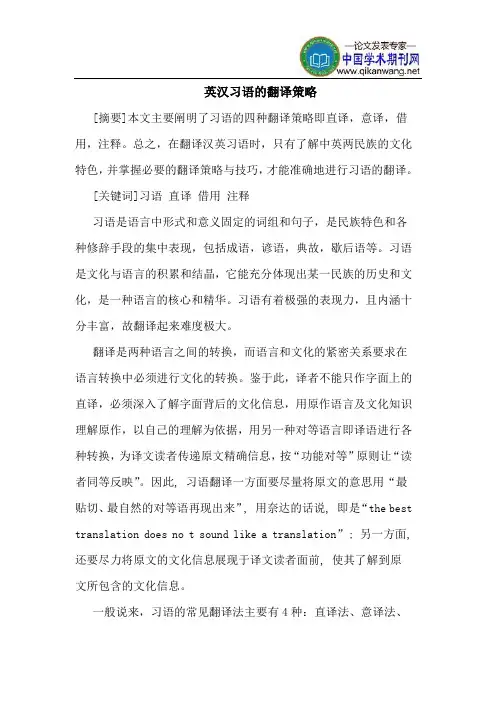
英汉习语的翻译策略[摘要]本文主要阐明了习语的四种翻译策略即直译,意译,借用,注释。
总之,在翻译汉英习语时,只有了解中英两民族的文化特色,并掌握必要的翻译策略与技巧,才能准确地进行习语的翻译。
[关键词]习语直译借用注释习语是语言中形式和意义固定的词组和句子,是民族特色和各种修辞手段的集中表现,包括成语,谚语,典故,歇后语等。
习语是文化与语言的积累和结晶,它能充分体现出某一民族的历史和文化,是一种语言的核心和精华。
习语有着极强的表现力,且内涵十分丰富,故翻译起来难度极大。
翻译是两种语言之间的转换,而语言和文化的紧密关系要求在语言转换中必须进行文化的转换。
鉴于此,译者不能只作字面上的直译,必须深入了解字面背后的文化信息,用原作语言及文化知识理解原作,以自己的理解为依据,用另一种对等语言即译语进行各种转换,为译文读者传递原文精确信息,按“功能对等”原则让“读者同等反映”。
因此, 习语翻译一方面要尽量将原文的意思用“最贴切、最自然的对等语再现出来”, 用奈达的话说, 即是“the best translation does no t sound like a translation”; 另一方面, 还要尽力将原文的文化信息展现于译文读者面前, 使其了解到原文所包含的文化信息。
一般说来,习语的常见翻译法主要有4种:直译法、意译法、借用法、注释法。
下面我们分别谈谈每种译法的具体思路。
一、直译法直译,指在不违背译文语言规范以及不引起错误联想的条件下,在译文中保留原习语的民族色彩、语言风格和比喻形象的方法。
例如:鱼目混珠—pass fish eye for pearls摊出最后一张牌—play one’s last card像狐狸一样狡猾—as cunning as a fox类似这样的习语译文,读者只要用心体会一下,就会明白其隐含意义,不但保留了原文的形象,而且增加了阅读的趣味二、意译法意译法指在充分理解原习语的基础上,舍弃其中陌生难懂的比喻形象而采用的一种方法。
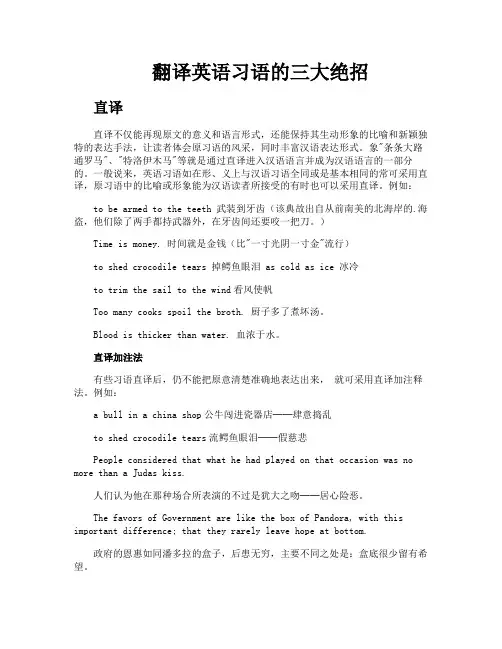
翻译英语习语的三大绝招直译直译不仅能再现原文的意义和语言形式,还能保持其生动形象的比喻和新颖独特的表达手法,让读者体会原习语的风采,同时丰富汉语表达形式。
象"条条大路通罗马"、"特洛伊木马"等就是通过直译进入汉语语言并成为汉语语言的一部分的。
一般说来,英语习语如在形、义上与汉语习语全同或是基本相同的常可采用直译,原习语中的比喻或形象能为汉语读者所接受的有时也可以采用直译。
例如:to be armed to the teeth 武装到牙齿(该典故出自从前南美的北海岸的.海盗,他们除了两手都持武器外,在牙齿间还要咬一把刀。
)Time is money. 时间就是金钱(比"一寸光阴一寸金"流行)to shed crocodile tears 掉鳄鱼眼泪 as cold as ice 冰冷to trim the sail to the wind看风使帆Too many cooks spoil the broth. 厨子多了煮坏汤。
Blood is thicker than water. 血浓于水。
直译加注法有些习语直译后,仍不能把原意清楚准确地表达出来,就可采用直译加注释法。
例如:a bull in a china shop公牛闯进瓷器店──肆意捣乱to shed crocodile tears流鳄鱼眼泪──假慈悲People considered that what he had played on that occasion was no more than a Judas kiss.人们认为他在那种场合所表演的不过是犹大之吻──居心险恶。
The favors of Government are like the box of Pandora, with this important difference; that they rarely leave hope at bottom.政府的恩惠如同潘多拉的盒子,后患无穷,主要不同之处是:盒底很少留有希望。
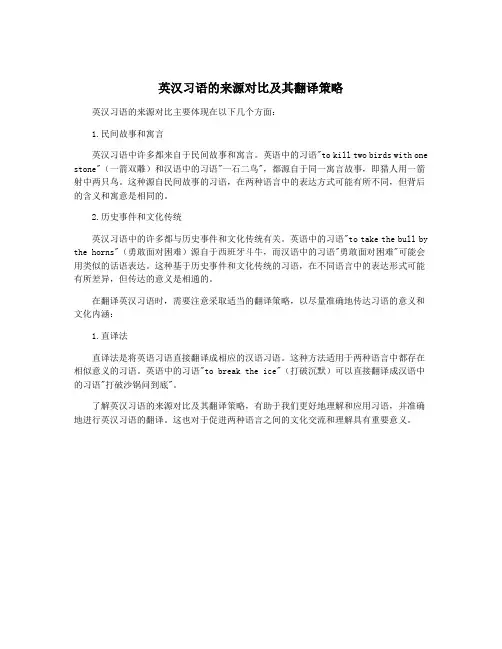
英汉习语的来源对比及其翻译策略
英汉习语的来源对比主要体现在以下几个方面:
1.民间故事和寓言
英汉习语中许多都来自于民间故事和寓言。
英语中的习语"to kill two birds with one stone"(一箭双雕)和汉语中的习语"一石二鸟",都源自于同一寓言故事,即猎人用一箭射中两只鸟。
这种源自民间故事的习语,在两种语言中的表达方式可能有所不同,但背后的含义和寓意是相同的。
2.历史事件和文化传统
英汉习语中的许多都与历史事件和文化传统有关。
英语中的习语"to take the bull by the horns"(勇敢面对困难)源自于西班牙斗牛,而汉语中的习语"勇敢面对困难"可能会用类似的话语表达。
这种基于历史事件和文化传统的习语,在不同语言中的表达形式可能有所差异,但传达的意义是相通的。
在翻译英汉习语时,需要注意采取适当的翻译策略,以尽量准确地传达习语的意义和文化内涵:
1.直译法
直译法是将英语习语直接翻译成相应的汉语习语。
这种方法适用于两种语言中都存在相似意义的习语。
英语中的习语"to break the ice"(打破沉默)可以直接翻译成汉语中的习语"打破沙锅问到底"。
了解英汉习语的来源对比及其翻译策略,有助于我们更好地理解和应用习语,并准确地进行英汉习语的翻译。
这也对于促进两种语言之间的文化交流和理解具有重要意义。

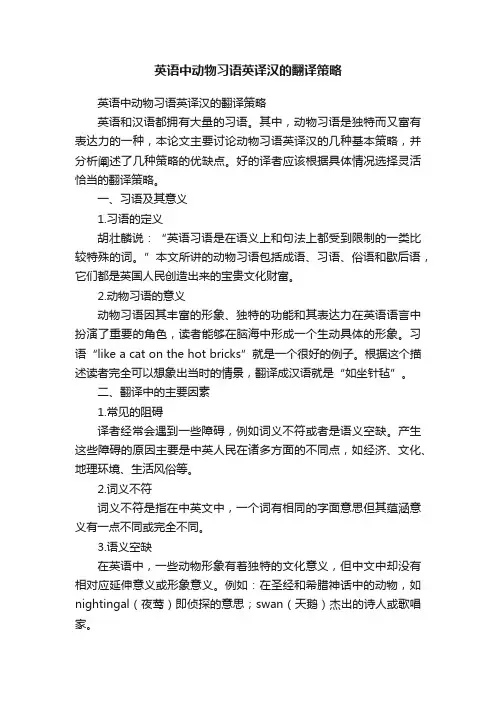
英语中动物习语英译汉的翻译策略英语中动物习语英译汉的翻译策略英语和汉语都拥有大量的习语。
其中,动物习语是独特而又富有表达力的一种,本论文主要讨论动物习语英译汉的几种基本策略,并分析阐述了几种策略的优缺点。
好的译者应该根据具体情况选择灵活恰当的翻译策略。
一、习语及其意义1.习语的定义胡壮麟说:“英语习语是在语义上和句法上都受到限制的一类比较特殊的词。
”本文所讲的动物习语包括成语、习语、俗语和歇后语,它们都是英国人民创造出来的宝贵文化财富。
2.动物习语的意义动物习语因其丰富的形象、独特的功能和其表达力在英语语言中扮演了重要的角色,读者能够在脑海中形成一个生动具体的形象。
习语“like a cat on the hot bricks”就是一个很好的例子。
根据这个描述读者完全可以想象出当时的情景,翻译成汉语就是“如坐针毡”。
二、翻译中的主要因素1.常见的阻碍译者经常会遇到一些障碍,例如词义不符或者是语义空缺。
产生这些障碍的原因主要是中英人民在诸多方面的不同点,如经济、文化、地理环境、生活风俗等。
2.词义不符词义不符是指在中英文中,一个词有相同的字面意思但其蕴涵意义有一点不同或完全不同。
3.语义空缺在英语中,一些动物形象有着独特的文化意义,但中文中却没有相对应延伸意义或形象意义。
例如:在圣经和希腊神话中的动物,如nightingal(夜莺)即侦探的意思;swan(天鹅)杰出的诗人或歌唱家。
三、基本翻译策略1.直译法两国人民的共同点是翻译的基础。
当两方用同一种动物来表达相同或相似的形象时,就使用直译法,例如都用“猪”来表明“肥胖”,用“羊”来表示“温顺”。
直译法有很多优点,它保持了原文的形式,在意义上不会引起混乱和误解,如“as fat as pig”可以翻译成“跟猪一样肥”。
“as gentle as a lamb”为“跟羊一样温顺”。
直译法能准确有效地表达原文的文化内涵,缩小了两种语言之间的差距。
2.意译法当英汉之间存在着相异之处时,可以考虑一下意译法。
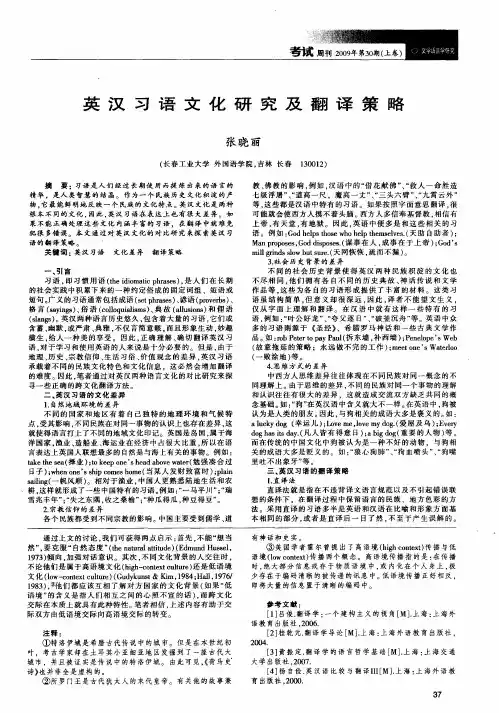
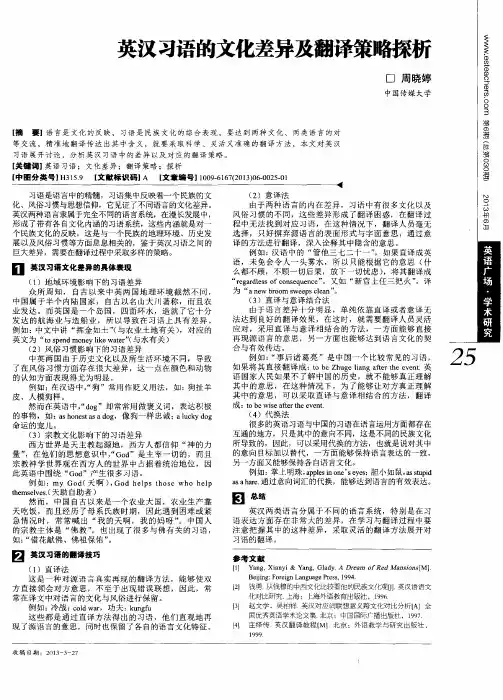
英汉习语的来源对比及其翻译策略1. 引言1.1 研究背景英汉习语在日常生活中被广泛使用,是两种语言文化交流的重要组成部分。
随着全球化的深入发展,英语和汉语的交流越来越频繁,因此对英汉习语的翻译研究也变得日益重要。
如何准确、恰当地翻译英汉习语成为研究者和翻译者共同关注的课题。
本文将对英汉习语的来源、对比以及翻译策略进行深入研究,探讨其中常见的翻译错误并提出解决方法,旨在为英汉习语的翻译工作提供一定的参考和帮助。
1.2 研究意义习语是每个语言中都存在的一种特殊表达形式,它们蕴含着丰富的文化内涵和历史背景。
英汉习语的比较研究不仅可以帮助我们更深入地理解两种语言的文化特点和传统,还有助于提升翻译水平和促进跨文化交流。
通过对英汉习语的来源、对比及翻译策略进行深入分析,我们可以更好地把握语言表达的奥妙,提高翻译质量和准确度。
研究英汉习语的翻译策略有助于翻译工作者更加准确地传达原文的意思,避免翻译过程中常见的错误和歧义,为跨文化交流搭建更加稳固和畅通的桥梁。
英汉习语的来源对比及翻译策略研究具有非常重要的意义和价值,对于提升翻译水平、促进文化交流和加深跨文化理解都具有积极的推动作用。
2. 正文2.1 英汉习语的来源英语习语的来源多种多样,通常包括历史、文化、传统、宗教等方面的因素。
在历史上,英语习语的形成受到了诸多影响,比如古代的希腊罗马文化、中世纪的基督教传统、文艺复兴时期的人文主义思想等。
这些文化因素都对英语习语的形成起到了重要作用。
另外,英语习语的来源还包括了许多民间传说、神话故事、历史事件等各种元素。
比如,许多习语源自莎士比亚的作品,比如“to be or not to be”、“star-crossed lovers”等。
这些习语以其独特的形式和含义被传承下来,成为了英语中的常用表达方式。
与英语习语相比,中文习语的来源也十分丰富多样。
中文习语通常包括了历史、文化、哲学、民间传统等多方面的影响因素。
比如,“井底之蛙”这个习语源自于古代的寓言故事,意味着目光短浅,不见世面。
英汉翻译中习语表达的翻译策略研究摘要:本研究旨在探讨英汉翻译中习语表达的翻译策略。
习语是语言中常见的表达形式,具有固定的词组或句子结构,其含义往往不可直接从字面意义推断。
由于英汉两种语言的文化差异和语言结构的不同,翻译习语表达面临一定的挑战。
本研究通过分析文献和实例翻译,总结出几种常见的翻译策略,包括直译、意译、换位、拆解和替代等。
每种策略都有其适用的场景和限制,翻译者需要根据具体情况进行选择。
本研究对于提高英汉翻译质量和准确传达习语的含义具有一定的指导意义。
关键词:英汉翻译,习语表达,翻译策略,直译,意译,换位,拆解,替代引言:随着全球化的不断发展,英汉翻译在各个领域中扮演着重要的角色。
习语表达作为语言中常见的固定结构,不仅在日常交流中广泛使用,而且在文学、商务和政治等领域中也频繁出现。
然而,由于习语的文化依赖性和语义的隐含性,翻译习语表达成为一项具有挑战性的任务。
本研究旨在对英汉翻译中习语表达的翻译策略进行深入研究,以帮助翻译者更好地理解和传达习语的含义。
1. 习语表达的特点与挑战1.1 习语的定义与分类习语是语言中常见的表达形式,由一组词语或句子组成,具有固定的结构和特定的含义。
与字面意义相比,习语的含义往往依赖于特定的文化、背景和语境。
在英汉两种语言中,习语的定义和分类存在一定的差异。
在定义上,习语可以被理解为一种特殊的语言表达形式,其意义不能直接从组成部分的字面意义推断出来。
习语的分类可以基于其形式、含义或使用领域。
常见的习语分类包括:成语(由四个字组成的汉语短语)、俚语(非正式的口语表达)、谚语(包含智慧和道德教诲的短句)、俗语(传统的或惯用的表达方式)等。
1.2 英汉习语表达的文化差异英汉习语表达面临的主要挑战之一是文化差异。
习语的含义往往与特定的文化和背景紧密相关,因此在翻译时需要考虑到不同文化之间的差异。
例如,在英语中,习语“kill two birds with one stone”意味着一举两得,而在汉语中,相似的习语“一箭双雕”具有相同的含义。
浅析英汉习语的翻译策略与方法作者:袁建伟来源:《青年文学家》2010年第17期一、引言习语是人类智慧的结晶,更是语言的精华。
Webster’s Third New International Dictionary 认为:“Idiom is an expression established in the usage of a language that is peculiar to itself either in grammatical construction or in having a meaning that can not be derived as a whole from the conjoined meaning of its elements.”从这个定义中我们可以看到idiom含有语义的统一性、语法结构的固定性以及不可替代性三个方面的特征,而且可以看到它的结构形式包含短语和短句两种类型。
本文所要研究的英汉习语主要是指俗语、谚语、成语、格言、俚语以及歇后语等,这些习语表现形式言简意赅,形象生动,妙趣横生,或含蓄幽默,或严肃典雅。
正是由于英汉习语具有这些特点,翻译习语时就要恰当处理语言和文化的矛盾,不仅要尽可能保持原文习语的形象比喻、丰富联想、修辞效果,还要尽可能保持其民族、地域特色,这样才能达到最佳程度的忠实原文和信息传递。
可见,习语翻译的好坏直接影响到整个译文的质量。
因此,如何恰当处理习语便成为英汉翻译中一个极为棘手又极其重要的问题。
笔者接下来主要探讨英汉习语翻译的基本策略和方法。
二、英汉习语的翻译策略与方法1.英汉习语的基本翻译策略习语大都具有鲜明的形象,适宜于用来比喻事物,因而往往带有浓厚的民族色彩和地方色彩。
习语有的意思明显;有的意在言外,能引起丰富的联想;有的甚至包含多重意思,因此,在翻译习语时必须根据上下文的具体情况来确定他的具体意义。
这就是英汉习语翻译的基本策略。
英汉习语的翻译方法英汉习语的翻译方法引导语:下面店铺给大家带来英汉习语的翻译方法,希望能够帮助到您,谢谢您的阅读。
一、直译法直译,指在不违背译文语言规范以及不引起错误联想的条件下,在译文中保留原习语的民族色彩、语言风格和比喻形象的方法。
例如汉语中的“纸老虎”直译成“paper tiger”,外国人看起来不但深明其义,而且觉得很是传神,所以该词现已成为英美民族的正式语言。
另外,汉语口语中的“丢脸”被直译为“lose face”,“功夫”则音译成“kung fu”等等。
当原习语的隐含意义很明显或很容易推断时,读者则可以通过字面领悟它的含义,直译字面意义。
如:“All roads lead to Rome.”译成“条条大道通罗马”;“A gentleman's agreement”译成“君子协定”;“雪中送炭”译成“To offer fuel in snowy weather”;“竹篮打水一场空”译成“T o draw water in a bamboo basket”。
类似这样的习语译文,读者只要用心体会一下,就会明白其隐含意义,不但保留了原文的形象,而且增加了阅读的趣味。
二、意译法有些习语由于文化因素的影响,在翻译时无法保留原本语句的字面意义和形象意义,也无法找到同义的习语借用,这时可将原文的形象更换成读者所熟悉的另一个译文形象,从而转达出原文的语用目的,译出隐含意义。
例如汉语中的“落花流水”通常是指被打得大败,译成英文便是“to be shattered to pieces”;“乌烟瘴气”形容情形混乱不堪,则可用“chaos”一个词来表达;“望子成龙”在英译时不能译出其形象,那么翻译成英文时就应该用简短的语句来形容该词的含义:“to expect one's son to become an outstanding personage”;又如:“The dog that will fetch a bone will carry a bone.”在译成汉语时,其中的字面形象dog、bone都不能直译,只能舍弃它的字面意义和形象意义,译出隐含意义:“对你说别人坏话的人,也会说你的坏话”。
英汉习语的来源对比及其翻译策略【摘要】英汉习语在翻译中具有重要的意义,因为它们反映了不同文化背景下的思维方式和表达习惯。
本文通过比较英汉习语的来源和差异,分析了翻译策略在习语翻译中的关键性作用。
在翻译中,需要选择合适的策略,并考虑到文化差异对习语翻译的影响。
习语翻译中常见的困难需要通过灵活的方法来解决。
在本文总结了习语翻译的挑战和技巧,提出了翻译策略的灵活运用和英汉习语翻译的发展趋势。
通过这篇文章的研究,读者可以更深入地了解英汉习语翻译的复杂性和方法。
【关键词】英汉习语,来源对比,翻译策略,文化背景,文化差异,困难与解决方法,挑战与技巧,发展趋势1. 引言1.1 英汉习语的来源英汉习语作为两种语言中常见的语言现象,源自于各自的文化和历史背景。
在英语中,许多习语的起源可以追溯到古代的文学作品、历史事件或民间传说。
“kill two birds with one stone”这个习语源自于古代的石头投掷比赛,意为一箭双雕。
而在汉语中,许多习语则是古代典故、民间传说或宫廷故事的产物。
“画蛇添足”这个习语源自于一个战国时期的故事,讲述一个人画了一条蛇,后来又在蛇脚下添加了蛇脚。
英汉习语的来源虽然各有不同,但它们都反映了当时人们的生活、文化和价值观念。
通过了解习语的来源,我们可以更好地理解其中蕴含的意义和传达的信息。
在翻译习语时,也需要考虑到其来源以及背后的文化内涵,才能更好地传达其意思和效果。
了解英汉习语的来源对于翻译工作者来说是非常重要的。
在接下来的内容中,我们将进一步探讨英汉习语在不同文化背景下的差异以及翻译策略的选择和应用。
1.2 英汉习语的对比英汉习语在语言表达方式、文化内涵以及使用场景等方面存在着一定的差异。
英语习语通常具有简洁、直接的特点,语言表达形式生动活泼,具有一定的幽默感和情感色彩,常常采用比喻、夸张或反讽等修辞手法。
而汉语习语则更注重形象生动、富有意境,通常以描绘事物形态或景物变化为基础,凸显了中国人尊重自然、注重精神层面的文化传统。
Cultural Default Reflected in Proverb T ranslation between English and Chineseand the Compensation StrategiesAbsrtact:Proverbs are the accumulation of human’s experience and wisdom. Different proverbs transmit different cultural information. If those cultural elements are not taken into consideration in the process of translation, cultural misunderstanding or cultural loss would arise. To deal with the cultural default in Chinese and English proverb translation, the author puts forward some compensation strategies.Key Words: Proverb Translation; Cultural Default; Compensation StrategyI. IntroductionProverbs are the crystals of human intelligence and experience. They do not only reflect human civilization but also enrich human life and make language more colorful. They are culturally influenced, thus bringing up difficulties in translation. As different nations have different cultures, whose uniqueness inevitably bring certain communication barriers between different countries and regions. Those differences may sometimes be culturally-specific, which means that what belongs to one culture may be vacant in another culture. This usually results in cultural vacuum, or in other words, cultural default. The translation between Chinese and English proverbs is affected greatly by the cultural elements of Chinese and English-speaking countries. Therefore, it is of great importance to find some compensation strategies to deal with the cultural default during the process of translation. Cultural default, if well handled, can improve the effectiveness of translation and enhance the communication.II. Cultural Default in Proverb Translation1. Definition and Current Studies of Cultural DefaultCultural default is a common phenomenon in communication, either in written texts or in colloquial form, and it has been attracting the attention of many scholars in recent years. Wang Dongfeng (2000: 234) defines it as “absence of relevant cultural background knowledge shared by the author and his intendedreader”. Wang Dalai (2004: 69) defines default specifically into three categories: Situational Default; Contextual Default and Cultural Default. He also puts forward his theories on cultural default and its compensational strategies. In his view, the principle for compensating cultural default in translation is to make the readers enjoy their process of probing cultures. Cultural default in proverbs is obvious or already-known to the language users, but it can always create a sense of vacuum for the outsiders because of the pote ntial discontinuity in translators’ interpretation. Li Jiachun and Cui Changliang (2007) express their views on cultural defaults and the strategies of cultural compensation in intercultural communication, in which they propose three strategies on compensating cultural defaults: domestication strategy, foreignization strategy and combined use of these two strategies.2. Classification of Cultural DefaultCultural default is a culture-specific phenomenon in communication. What is easy and obvious to the source language (abbreviated as SL) reader in the form of cultural default is often inconspicuous and opaque to the target language (abbreviated as TL) reader. The unavoidable existence of cultural default embedded in the source text and its function will force us to face the fact that the source proverbs can not reflect the translated language’s flavor. So,in the process of translation, cultural default poses a big problem to the translator. In order to deepen the study of cultural default, it is necessary for us to divide it into different categories or types. In the thesis the author makes a general classification of cultural default reflected in proverbs as follows:2.1 LegendsLegends of ancient Greek and Rome have been exerting enormous influence on western culture, and people who come from western culture are quite familiar with most of those legends. However, those stories from legends are often treated as default elements because other readers are not familiar with them. Likewise, people from other cultures may be at a loss when they first come across Chinese proverbs. Take the Chinesefamous legendary proverb“狗咬吕洞宾,不识好人心”for example. Y ang Xianyi(2003) translates it as “Y ou ungrateful thing! Like dog that bit Lu Dongbin----you bite the hand that feeds you.” If it is translated as “A dog that bites on Lv Dongbin can not distinguish a good person’s heart from a bad person’s heart”,the foreign readers will be confused for it fails to carry the underlying meaning to readers but adds bewilderment to foreign readers. Such proverbs are cultural proverbs; they were born and grow with a particular legendary story. Native readers would understand them without any difficulties, but target readers may not know them. So translating this kind of proverbs usually needs to add the background story to the translated text.2. 2 Historical EventsThere are such different genres of story that were inherited from ancient times, such as myths, fables, folklores, legends, etc. Ancient stories that happened in history are also another group. Culture abounds with colorful stories. They have been passed down from generation to generation and have nourished the culture to which they belong for centuries. The English proverb “somebody meets his Waterloo’s battle”is quite familiar to westerners, which can be translated into Chinese as“遭遇滑铁卢,遭受致命的失败”. However, many Chinese don’t know much about what happened in Waterloo, so it is necessary to introduce the background knowledge of this proverb. Napoleon, the great French revolutionary general and also a dictator, was heavily defeated by Anglo-Prussian alliances at waterloo in Belgium on June 18th, 1815, which marked the start of his decline and collapse. Since then he was unable to restore his army from failure. Ever since this event, people use“meet one’s waterloo” to mean one encounters failures or gets defeated by others. A Chinese reader can not understand this phrase as it is so closely connected with the historic events that happened in French history. In this sense, the proverb “meet one’s waterloo” is an example of cultural default resulting from historic events.2.3 Religious StoriesReligious culture is an important part of a nation's culture, which includes the nation's religious beliefand ideology. Buddhism and Taoism have great influence on Chinese people while Christianity has a great effect on the western world. When people from Chinese culture get into trouble, they will talk to Buddha and ask him for help and utter “Gracious Buddha”.In English-speaking countries, Christ is worshipped by millions of people and the basic concepts of Christianity are criteria for an individual's behaviors.To some extent, Bible can be called the guide book for westerners. Westerners will exclaim “God bless you” or “God bless my soul” when they express their regards or pray.As for proverbs that have distinct Chinese color, they are often influenced by Buddhism and Taoism. Therefore, there are a lot of expressions related to Buddhism and Taoism in Chinese proverbs, which are usually treated as culturaldefault elements. Take the Chinese proverb“闲时不烧香,临时抱佛脚”(Zheng Xunlie,1985:214)for example. We translate it literally as “clasp the feet of Buddha”. The proverb means that when someone gets stuck into a difficult situation caused by lack of preparation, he looks for help at the last critical moment. In ancient China, when Buhhdism was very popular in the Nan Dynasty, it is said any criminal who was to embrace Buddha's feet and prayed for help would be pardoned.“抱佛脚”if translated literally, does not make sense to the TL reader. Thus as translators, whoever translates this proverb should adopt a skillful translation approach, and should point out the default meaning and let the TL readers understand the specific Chinese cultural meaning in it.2.4 Literary WorksMany proverbs in literary works, when translated, reflect cultural default. There is a proverb taken from Charlotte Bronte’s Jane Eyre: “Conventionality is not morality. Self-righteousness is not religion. To attack the first is not to assail the last. To pluck the mask from the face of the Pharisee is not to lift an impious hand to the Crown of Thorns.” Guo Jianzhong (2000:244) translates it into Chinese as “惯例不是道德, 自作正经不是宗教。